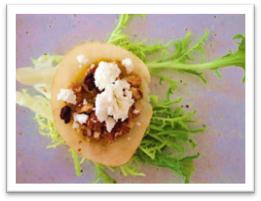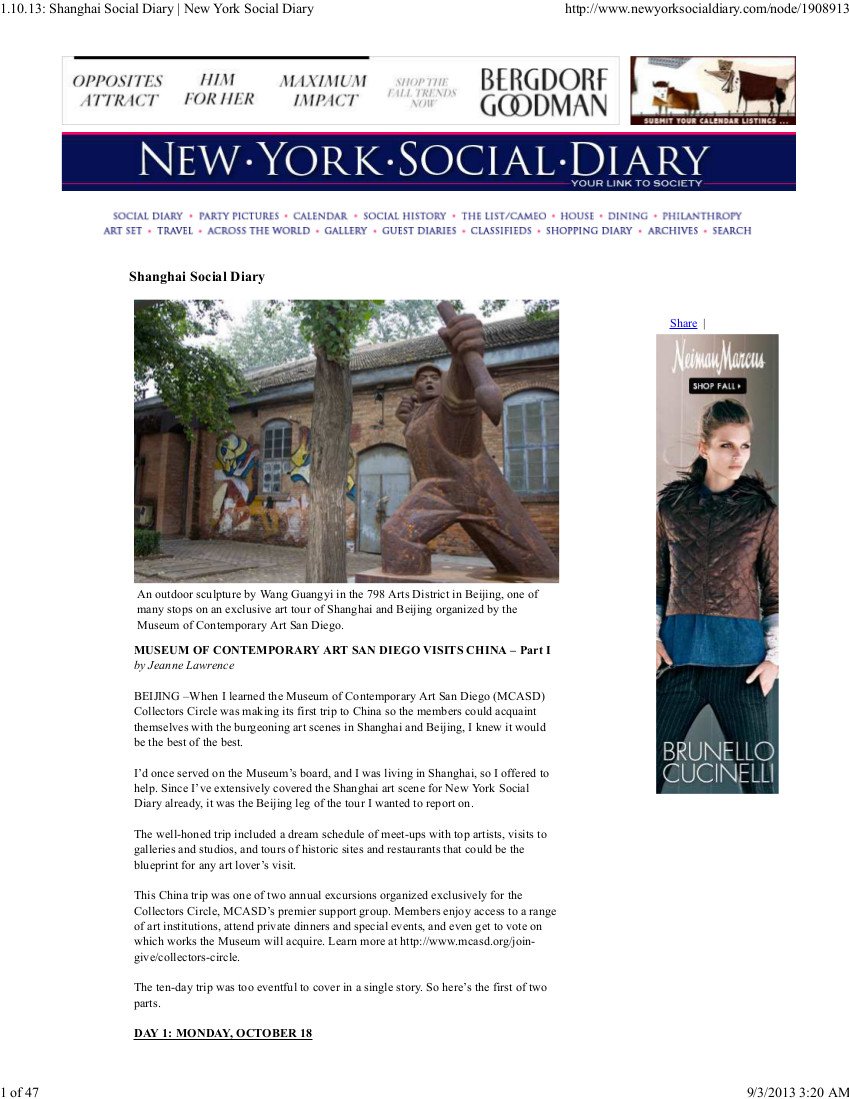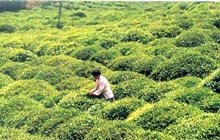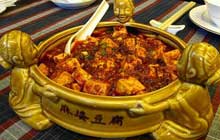Attention travelers, leave the canned food and misconceptions at home… it’s time to eat your way through China.

Minced chicken with pine nuts inside a sesame bun. Pizza with broccoli, buffalo mozzarella and red chili powder. Vegetarian duck, stuffed with soy braised shitake mushrooms and veggies. Cream of green tea with a crunchy center of Jivara chocolate served on a hazelnut biscuit. Is this a menu from San Francisco’s restaurant scene? Nope, these menu items can be found in China, where celebrity chefs have created considerable buzz and where foodie culture has spread to the best restaurants in Beijing, Shanghai and Hong Kong.
Often subjected to questionable touristy restaurants, many visitors fail to discover the best dining experiences that China has to offer. It’s a shame too, after all, this is the country where the locals greet each other by asking, “have you eaten yet?” Sadly, when the food in China makes the Western news or appears in social media, it is generally with dramatic headlines about contamination or about bad dining experiences.
 China’s restaurant culture is now as sophisticated as its up-and-coming art, fashion and design scenes. So why do so many tour companies continue to subject their guests to crowded, touristy restaurants? Even beyond Hong Kong, Beijing and Shanghai, it is possible to enjoy unforgettable dining experiences, like a catered alfresco Tibetan lunch at a monastery overlooking the Himalayas while musicians play for you, or a Silk Road BBQ amidst the sand dunes Dunhuang as you watch the sun rise.
China’s restaurant culture is now as sophisticated as its up-and-coming art, fashion and design scenes. So why do so many tour companies continue to subject their guests to crowded, touristy restaurants? Even beyond Hong Kong, Beijing and Shanghai, it is possible to enjoy unforgettable dining experiences, like a catered alfresco Tibetan lunch at a monastery overlooking the Himalayas while musicians play for you, or a Silk Road BBQ amidst the sand dunes Dunhuang as you watch the sun rise.
Nine distinct regional cuisines (depending on who you ask, some say more, some say fewer). Dining venues that fascinate and intrigue you. Home to over 1 billion foodies, 7 Michelin Star restaurants, culinary events like the Shanghai Masters of Food & Wine event, and a new wave of humble chefs transforming the dining experience in China. Have you eaten yet?
Lisa Reyes joined Imperial Tours in 2008 and works out of the company’s sales and marketing office in San Francisco. She is passionate about food, foreign films, music and camping, not necessarily in that order. Ask Lisa about her mom’s transformative first trip to China.

Three Michelin Star Chef Alain Passard
Rather than slaving over a Thanksgiving feast this year, wouldn’t you prefer to have sumptuous dinners with not one, but two separate Michelin 3 star chefs…in China?
Imperial Tours is offering a 6-night private culinary adventure through Shanghai and Hangzhou Nov 25 – Dec 1, 2014 in conjunction with the Park Hyatt Shanghai's annual "Masters of Food and Wine" event.
Highlights include:
• VIP airport meet and greet including Diplomatic Channel access
• 4 Nights at the Park Hyatt Shanghai
• 2 Nights at the Four Seasons Hangzhou
• Exclusive privately guided tours of Shanghai and Hangzhou
• Floral design master class with celebrity florist Yuji Kobayashi and master florist Jackey Wu
• Gala dinner presented by 3 Star Michelin celebrity chef Yannick Alleno of Cheval Blanc Courcheval
• Master baijiu (a Chinese distilled liquor) class with Chinese wine master Biao Zhuo
• Gala dinner hosted by 3 Star Michelin chef Alain Passard from L'Arpege
Click here for a full itinerary based on two people traveling: Masters of Food & Wine.
High end foodies will not want to miss this trip! We can customize this itinerary in any way to suit your needs, interests and number of travelers. For a slightly longer itinerary, why not pair it with some holiday shopping in either Shanghai or Beijing? Coincidentally, November also happens to be Wine & Dine month in Hong Kong, so that could also be a terrific add on.
For more information or to book the trip, please contact Priscilla Tan.

To carry on reading about this trip, please visit the New York Social Diary website.
Anyone with an interest in food, wine and entertaining, will be excited that Imperial Tours is offering a 6 night private culinary trip through Shanghai and Hangzhou Nov 27 – Dec 3, 2013 in conjunction with the Park Hyatt Shanghai's annual "Masters of Food and Wine Festival".
The itinerary for two incorporates the following highlights:
• VIP airport meet and greet including Diplomatic Channel access
• 4 Nights at the Park Hyatt Shanghai
• 2 Nights at the Four Seasons Hangzhou
• Contemporary art and expert-led colonial architecture tours of Shanghai
• Private club, West Lake, Buddhist temples and tea specialist tour in Hangzhou
• Champagne class with Ned Goodwin, Master of Wine from Tokyo
• Gala dinner presented by Two Star Michelin Master Chef Jean-Luc Rocha from Chateau de Corbeillan-Bages
• Floral design class by French Master Florist Sebastien Lathuile and Park Hyatt Master Florist Emily Zhou
• Closing gala dinner hosted by Three Star Michelin Chef Anne-Sophie Pic of Maison Pic.
High end foodies will not want to miss this trip! Imperial Tours is able customize this itinerary in any way to suit travelers' needs. For a slightly longer itinerary, we can suggest pairing it with some holiday shopping in either Shanghai or Beijing, or both!
For questions or a copy of the itinerary with pricing, please email Priscilla Tan in our Shanghai office.

For full article see www.nxtbook.com

Spring is an exciting time for all tea lovers, as that’s when the best green teas are picked and hit the market, with the top quality ones, extremely rare teas auctioned at dizzyingly high prices. Not many in the West know, though, that China produces an even more delicate, unprocessed and nourishing variety of tea: White Tea.
The best quality is known as “White Hair Silver Needle” or Bai Hao Yin Zhen 白毫银针 in Chinese. Produced in the southern Fujian province, gathered only for a few days in early spring each year, this is the most prized variety among white teas; only the first, most tender unopened buds are selected and plucked by expert hands. It takes more than 4,500 hand-picked buds to make just one pound of this celebrated tea.
The name “White Hair Silver Needle” comes from the tiny hairs visible both on the buds and in the liquor they produce; this is where most of the precious antioxidants, particularly abundant in white teas, are found. White teas are the least processed and therefore retain the highest levels of nutrients and antioxidants.
This delicate tea is best prepared with water below boiling temperature (at around 70 to 80 degrees Celsius, or around 160 to 175 degrees Fahrenheit) and produces a pale yellow tea particularly delicate and sweet. It is very important not to steep white and green teas too long, or they may turn bitter, especially if they are not of top quality or very fresh. To allow the plump buds to develop their full flavor, steeping time should be longer than other white teas, up to 1 minute for the first infusion, adding 1 additional minute for the subsequent 2nd and 3rd infusions. I would suggest using approximately 4g (about 2 tablespoons) of Silver Needle for each cup of water, but feel free to experiment to obtain the strength you prefer. Enjoy!
 Tea is one of ancient China's many inventions. The English word "tea" is derived from the word te, which hails from the southern port town of Xiamen (Amoy). Although it was only introduced to Europe and America in the seventeenth century, human cultivation of tea plants dates back two thousand years in China. In fact, during the Neo-Daoist revival of the ninth and tenth centuries, tea became an integral part of scholastic life. The preparation and drinking of tea symbolized man's potential for harmony with nature. The tea ceremony came to be a theater for spiritual enlightenment through the contemplation of the universe.
Tea is one of ancient China's many inventions. The English word "tea" is derived from the word te, which hails from the southern port town of Xiamen (Amoy). Although it was only introduced to Europe and America in the seventeenth century, human cultivation of tea plants dates back two thousand years in China. In fact, during the Neo-Daoist revival of the ninth and tenth centuries, tea became an integral part of scholastic life. The preparation and drinking of tea symbolized man's potential for harmony with nature. The tea ceremony came to be a theater for spiritual enlightenment through the contemplation of the universe.
This article lists the various categories of tea available in China and describes the process for making Hangzhou's famous Longjing tea. For more information, join us on a tour of Hangzhou's tea museum.
The Various Categories of Tea
1) Green tea . So called, since the green tea leaves are not fermented during processing, thereby maintaining the original colour. Famous examples are Longjing tea of Zhejiang province, Maofeng of Huangshan Mountain in Anhui province and Biluochun produced in Jiangsu province.
2) Black tea . Developed after green tea, it incorporates fermentation within the baking process. The best brands are Qihong of Anhui province, Dianhong of Yunnan, Suhong of Jiangsu, Chuanghong of Sichuan and Huhong of Hunan.
3) Wulong tea . This represents a variety half way between green and black teas. It is a special tea made and enjoyed in Fujian, Guangdong and Taiwan – all located on China's south-east coast.
4) Compressed tea . Also known as "brick tea" because it is compressed and hardened into a brick-like shape, this tea is convenient for transportation and storage. It is often supplied to nomadic peoples on China's borders, e.g. to clans in Mongolia.
5) Scented tea . This is made by mixing fragrant flowers with the tea leaves during processing. The flowers most commonly used for this are jasmine and chrysanthemum.
To Make Green Tea
To make Longjing (Dragon Well) Tea, bushes must be picked between twenty to thirty times between March and October. This is not done by machine but by hand, with an experienced leaf-picker able to collect six hundred grams or nine thousand green tea leaves per day. For all but the very finest tea, these fresh leaves are immediately parched by machine in electrically heated cauldrons.
Six hundred grams of fresh green leaves (or one day's worth of picking), after baking, will leave you with one hundred fifty grams of parched tea.
 Day One
Day One
Today you will fly to Chengdu, the capital of modern Sichuan province. A historic capital serving as the traditional gateway to the Tibetan plateau, Chengdu has in recent years become a vibrant and sophisticated metropolis. Prepare yourself for mouth-watering Sichuan food, wonderful cultural sites and of course one of the rarest bears on our planet. (Shangri-la Hotel – Executive Riverview Room) (B, L, D)
Day Two
Early this morning we will take you to the Panda Research Institute, set within spacious parkland, where you will be able to observe pandas being fed a breakfast of bamboo shoots in their lush green pens.
Before lunch, we will visit a traditional Chengdu street to view, if not taste, some traditional Sichuanese street foods and tea-houses. This afternoon, you will drive an hour outside the city to visit one of the most mysterious archaeological discoveries of the twentieth century – Sanxingdui. The site is believed to date from the third millennium BCE. As well as cast bronze "sacred trees" on which stand molded singing birds and hundreds of jade and lacquer wares, there are a series of gold-plated bronze masks that are astonishingly beautiful. Compounding the archeological wealth of Sanxingdui is the silence of any historical record positioning this advanced civilization within the arc of China 's pre-history. This has wrapped the site in a shroud of mystery as intriguing and compelling as that of the Egyptian pyramids. (B, L, D)
Day Three
This morning, we will travel to one of China's most important Daoist Temples, Qingyang Temple. Daoism as a religious practice and institution incorporates a broad and set of historic disciplines within its belief system. As well as the worthwhile chemical and herbal research completed over the ages in pursuit of an "Immortality Pill", Qingyanggong also has a Daoist orchestra, a Taiji master, a Taiji tea instructor, a homeophathic doctor and a Daoist restaurant. Quite apart from a personal meeting with a Daoist monk to learn about such ideological matters as synchronicity, the Eight Trigrams and their interaction with the energy forces of Yin & Yang, visitors will be able to investigate some of the above disciplines and also tour the living quarters of the monks. You will be transferred to the airport in time for your flight to your next destination. (B, L)
Please note that B, L, D denotes Breakfast, Lunch Dinner.